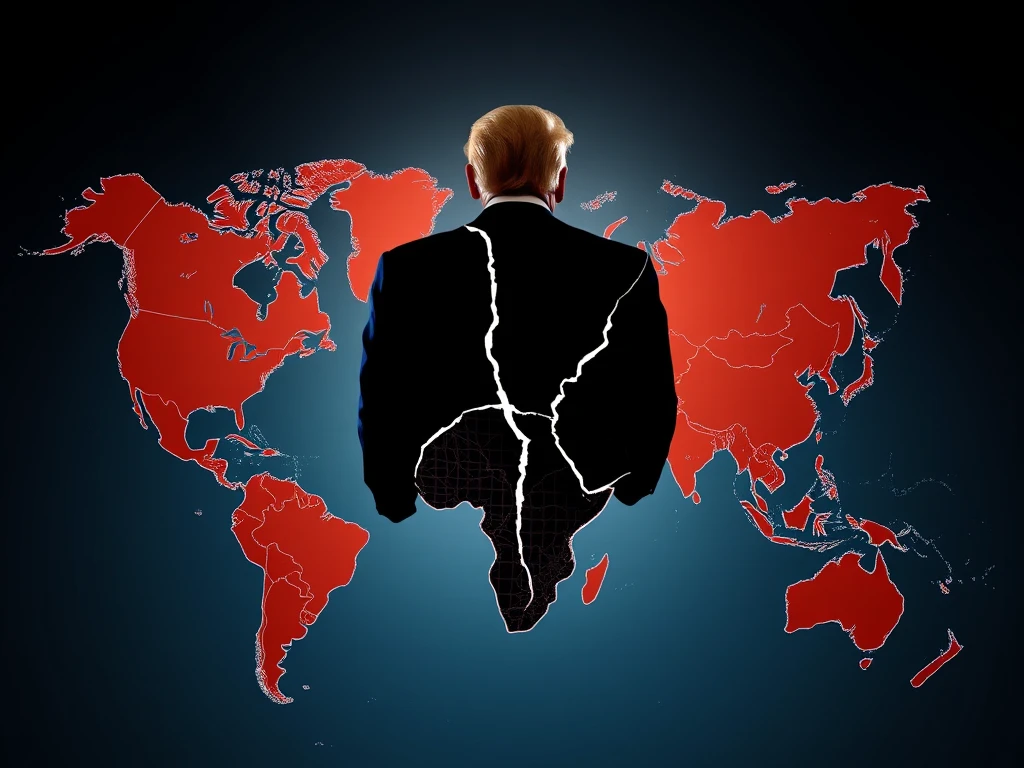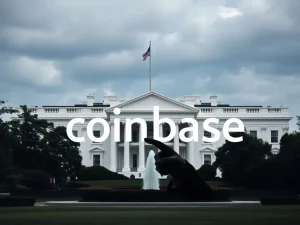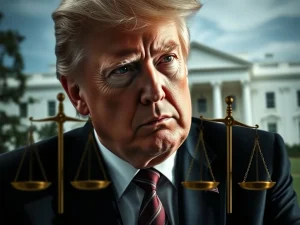Sweeping Trump Tariffs Threaten Global Trade: A Bold Economic Policy Shift?

Buckle up, crypto enthusiasts and economic observers! A seismic shift in global trade policy is underway as former US President Donald Trump has announced sweeping new tariffs. In a move that has sent ripples across financial markets, including the crypto sphere, Trump has imposed a 10% tariff on imports from all countries and introduced reciprocal levies on trading partners. Is this a return to protectionist policies of the past, and what does it mean for the future of the US and the world economy? Let’s dive into the details of these Trump Tariffs and explore the potential implications.
What are These New US Tariffs All About?
According to the recent announcement, the US Tariffs are structured in two key ways:
- Baseline Tariff: A flat 10% tariff on all goods imported into the United States, regardless of their origin.
- Reciprocal Levies: These are designed to mirror the tariffs imposed by other countries on US exports. For instance, if a country charges a 67% tariff on US goods (like the example given for China), the US will impose a Reciprocal Tariff of approximately half that rate, in this case, 34%.
- Automobile Tariff: A specific 25% tariff is being applied to all imported automobiles.
Trump framed these measures as a return to economic policy that fueled American prosperity in the 19th century. He argued that tariffs were the backbone of US wealth before the introduction of income tax in 1913. He even suggested that the revenue generated from these tariffs could potentially replace the income tax system altogether.
The Rationale Behind Reciprocal Tariffs: Fair Trade or Protectionism?
Trump’s administration is positioning these Reciprocal Tariffs as a matter of fairness. The argument is that if other countries impose high tariffs on American goods, the US should respond in kind to level the playing field. However, critics argue this is a form of protectionism that could harm global trade and potentially trigger trade wars.
Key Arguments for Reciprocal Tariffs:
- Fairness and Level Playing Field: Ensuring that US exporters are not disadvantaged by higher tariffs imposed by other nations.
- Economic Leverage: Using tariffs as a tool to negotiate better trade deals and encourage other countries to lower their tariffs on US goods.
- Revenue Generation: Potentially generating significant revenue for the US government, which could be used to reduce or replace other forms of taxation.
Potential Challenges and Concerns:
- Trade Wars and Retaliation: Other countries may retaliate by imposing their own tariffs on US goods, leading to escalating trade tensions and harming global trade.
- Increased Costs for Consumers: Tariffs are essentially taxes on imports, which can increase the cost of goods for American consumers and businesses.
- Damage to International Relations: Aggressive tariff policies can strain relationships with trading partners and undermine international cooperation.
Could Trade Tariffs Really Replace Income Tax?
One of the most radical aspects of Trump’s proposal is the idea of eliminating the IRS and funding the federal government solely through Trade Tariffs. This concept was floated during his campaign and is now being brought to the forefront. Proponents argue this could simplify the tax system and shift the tax burden from American citizens to foreign producers and consumers of imported goods.
Potential Benefits of Replacing Income Tax with Tariffs (as argued by proponents):
- Tax Savings for Americans: Estimates suggest significant lifetime tax savings for individual taxpayers if income tax is eliminated.
- Simplified Tax System: Eliminating the complex income tax system and the IRS could lead to greater simplicity and reduced compliance costs.
- Economic Protectionism: Tariffs could incentivize domestic production and reduce reliance on imports, potentially boosting American industries.
Major Challenges and Criticisms:
- Economic Viability: It’s unclear whether tariff revenue alone would be sufficient to fund the entire federal government, especially considering potential declines in import volumes due to tariffs.
- Regressive Impact: Tariffs could disproportionately affect lower-income households who spend a larger portion of their income on goods, potentially making essential items more expensive.
- Global Economic Instability: A complete shift to tariff-based funding could destabilize global trade and financial systems, leading to unpredictable economic consequences.
What’s the Crypto Angle? Will a Tariff War Stop the Party?
The original article mentions the question: “Bitcoin rally to $88.5K obliterates bears as spot volumes soar — Will a tariff war stop the party?” This highlights the potential impact of these economic policy shifts on the cryptocurrency market. Increased economic uncertainty and potential inflation driven by tariffs could influence investor behavior in the crypto space. Some argue that crypto, particularly Bitcoin, could be seen as a hedge against economic instability and currency devaluation in a tariff-heavy world.
However, a full-blown trade war could also dampen overall economic sentiment, potentially leading to risk-off behavior and impacting all markets, including crypto. The interconnectedness of global finance means that major shifts in trade policy will inevitably have ripple effects across different asset classes.
Final Thoughts: A Bold Gamble or Economic Recklessness?
Trump’s sweeping tariff announcement is undoubtedly a bold move that signals a significant shift in US economic policy. Whether it’s a calculated gamble to restore American economic dominance or a reckless step towards protectionism remains to be seen. The coming months will be crucial in observing the global reaction, the economic impact, and the ultimate consequences of these Trump Tariffs. For crypto enthusiasts and investors, staying informed and understanding the broader economic landscape is more critical than ever as these policies unfold.








